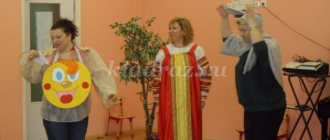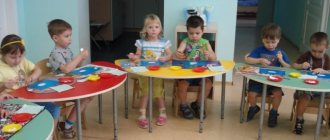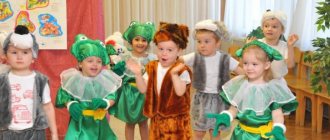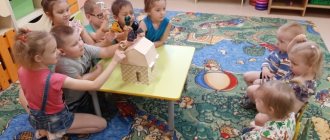Presentation “Getting to know the theater” presentation for the lesson (senior group) on the topic
Conversation for the virtual trip “Getting to know the theater.”
Goal: To develop interest in the theater and theatrical activities.
Tasks:
- Expand children's knowledge about theater as a type of art;
- Strengthen your knowledge of theaters;
- Continue to introduce theatrical terminology (actor, director, lighting designer, costume designer, make-up artist);
- Activating children's speech through the development of dialogic conversation, introducing new words and concepts into the active vocabulary (Foyer, spotlights);
- Fix the text of S. Marshak’s poem “In the Theater for Children”;
- To consolidate knowledge of the professions of people serving in the theater;
- Foster a culture of communication between children, children and adults;
- Continue to develop the ability to comply with the rules of behavior in the theater.
Material: electronic presentation “Getting to know the theatre.”
Preliminary work: looking at photographs of the theater.
Activation of the dictionary: wardrobe, cloakroom attendant, foyer, usher, orchestra pit, director, actor, role, prop man, make-up artist, applause, costume designer, artist, cashier. Progress of the conversation:
Educator: Children, today we will talk about the theater. What is theater?
Children: The theater is an amazing house where they show performances, fairy tales, where they dance and sing, and recite poems.
Educator: Guys, have you been to a real theater?
Children: No.
Educator: Why do you think people go to the theater?
Children: Adults and children go to the theater to watch a play, a fairy tale, listen to music, learn new things, and relax.
Educator: Every visit to the theater is a holiday! The word THEATER came to us from the Greek language and means “place for spectacle, spectacle.” But theater is not only an art form, but also a building where we come to performances. Want to know more about theatre? Children: Yes. Educator: Let's go to the theater. And I will be your tour guide. I invite you on a tour! Slide 1 INTRODUCTION TO THE THEATER Educator: Theaters come in different genres: theaters in which the actors do not talk, but sing, and their singing, stage action and actions are consistent with music written specifically for this play - this is opera.
Slide 2 OPERA AND BALLET THEATER
Slide 3 OPERA In opera they do not speak, but sing. What an opera singer sings is called an aria.
Theaters in which the actors do not talk, but dance, and all feelings are expressed through dance movements - this is ballet. Slide 4 BALLET Ballet dancers tell the audience about all the events and relationships of the characters with each other through dance.
Slide 5 Many wonderful operas and ballets are based on fairy tales. Alice in Wonderland The Nutcracker The Tale of Tsar Saltan
Slide 6 DRAMATIC THEATER In a drama theater, actors talk. The playwright talks about the characters and events in the play through dialogues.
Slide 7 THEATER OF ANIMALS
The oldest theater exists in Moscow - the theater of V. L. Durov. “Grandfather Durov’s Corner” where animals perform: hippopotamus, elephant, raven, pelican, raccoon and many others.
Slide 8 PUPPET THEATER There are puppet theaters where spectators look not at live actors, but at puppets controlled by the artists. Slide 9 GLOVE DOLLS Slide 10 PUPPETS
Slide 11 SHADOW THEATER
Slide 12 FOYER
Slide 13 AUDITORIUM Let's look at the auditorium. The most important place in the auditorium is the stage on which the performance is performed. The scene itself is not yet visible. It is still closed with a curtain. If you are sitting far from the stage, you will need theater binoculars, which you can bring with you or purchase from the cloakroom. PARTERRE BENOIR MEDIUM FLOORS 1st TIERC 2nd TIERC BALCONY
Slide 14 ORCHESTRA PIT. Musical operas and ballets, in opera the artists sing, they are called soloists, and they are assisted by choreographers and an orchestra. The orchestra is led by a conductor so that the musicians play in the same rhythm and tempo, and in ballet the artists dance. A choreographer helps them in staging the dance. The musicians are sitting in the orchestra pit. The orchestra pit is a special room for the orchestra in the theater, located in front of the stage.
Slide 15 CURTAIN What is a theater curtain? This is a canvas that covers the stage from the audience. The performance will begin as soon as the curtain rises or moves apart, as they are sliding or rising.
Slide 16 DECORATIONS The scenery for the performance is made in the workshop according to the sketches of the decorative artists.
Slide 17 The scenery for the performance is made in the painting and decoration workshop according to the artists’ sketches.
Slide 18 PROPERTIES Props are fake, specially made objects of sculpture, furniture, and dishes used in theatrical performances instead of real things. A theater worker who makes props is called a prop maker. Crockery, food, weapons, and furniture can be props.
Slide 19 SPOTLIGHTS With the help of spotlights, lighting designers can depict a sunrise or sunset, flashes of lightning, a starry sky and much more on stage.
Slide 20 During a performance, a sound engineer can turn on a soundtrack: the sound of rain or the roar of waves, the roar of the crowd or the whistle of the wind - depending on what is happening on stage at that time.
Slide 21 Before the performance, the make-up artist applies makeup to the actors. An experienced master can change an actor's face beyond recognition.
Slide 22 Actors for a performance may need a variety of costumes - ancient, modern, and even fairy-tale. The entire costume must first be designed and then drawn by the artist. The tailors will then bring his ideas to life. Masters can paint a piece of burlap in such a way that from the audience it will seem like rich brocade, velvet or silk.
-And the most important person who runs the whole performance is the director. He chooses which play to stage, assigns roles, organizes and conducts rehearsals and everything that happens on stage.
Slide 23 DIRECTOR The director also chooses which play to stage, works with the production designer, and organizes everything that happens on stage.
Slide 24 Finally, the performance is ready, and the theater invites the audience. The new performance is called the premiere. So, you and I are spectators. The performance will begin soon and it’s time for us to go to the auditorium. But what is it? (Bell) Which of you is the most attentive and heard an unusual sound? This is a theatrical call. In total, the theater rings three bells before the start of the performance. The third bell indicates that the performance is beginning. After the third ring, the lights in the hall go out. It is indecent to enter the auditorium after the third bell.
Slide 25Applause! Educator: Our excursion has come to an end, did you enjoy the trip? Children: Yes. Educator: What did you like most? Let's remember where we've been? What did you see? Well done! You were attentive, it's time to return to kindergarten.
Theatrical activities in preschool educational institutions presentation on the topic
Slide 1
Theatrical activities in preschool educational institutions Prepared by: senior teacher of MBDOU d/s No. 27 “Charoit” Kiseleva M.I.
Slide 3
“Creative processes are better expressed in children’s games. Children playing represent examples of the most genuine, most genuine creativity” L.S. Vygotsky
Slide 4
“The game is a kind of center around which the main interests and experiences of children are concentrated” L.I. Bozovic
Slide 5
Dramatic play is creative play. It represents the acting out of literary works (fairy tales, short stories, specially written dramatizations). The heroes of literary works become characters, and their adventures and life events, changed by children's imagination, become the plot of the game.
Slide 7
Children's whole life is filled with play. Every child wants to play their role. Teaching a child to play, take on a role and act, while at the same time helping him gain life experience - theater helps to achieve all this.
Slide 8
Theater is a means of emotional and aesthetic education of children in preschool educational institutions
Slide 9
Theatrical activities in kindergarten This is a good opportunity to reveal the creative potential of the child and nurture the creative orientation of the individual. Children learn to notice interesting ideas in the world around them, embody them, create their own artistic image of a character, they develop creative imagination, associative thinking, speech, and the ability to see unusual moments in the ordinary. Theatrical activities help the child overcome timidity, self-doubt, and shyness. Thus, theater helps the child develop comprehensively.
Slide 10
Theatrical activities Bring variety to a child's life. It gives joy to the child and is one of the most effective ways of corrective influence on the child, in which the principle of learning is most clearly manifested: learn by playing.
Slide 11
In the process of theatrical games: Children’s knowledge about the world around them expands and deepens. Mental processes develop: attention, memory, perception, imagination. Various analyzers are developing: visual, auditory, speech, motor. Vocabulary, speech structure, sound pronunciation, coherent speech skills, tempo, expressiveness of speech, and the melodic and intonation side of speech are activated and improved. Motor skills, coordination, smoothness, switchability, and purposefulness of movements are improved. The emotional-volitional sphere develops, children become familiar with the feelings and mood of the characters, and master ways of expressing them externally. Behavior correction occurs. A sense of collectivism and responsibility for each other develops, and the experience of moral behavior is formed. The development of creative, search activity, and independence is stimulated.
Slide 12
Types of dramatization are: Games-imitation of images of animals, people, literary characters; Role-playing dialogues based on text; Staging of works; Staging performances based on one or more works; Improvisation games with the acting out of a plot (or several plots) without prior preparation.
Slide 13
Types of director's games are determined in accordance with the variety of theaters used in kindergarten: tabletop, flat, three-dimensional, puppet (bi-ba-bo, finger, etc.)
Slide 14
The main directions of work with children in preschool educational institutions Theatrical play is a historically established social phenomenon, an independent type of activity characteristic of humans. Rhythmoplasty includes complex rhythmic, musical, plastic games and exercises designed to ensure the development of natural psychotropic abilities of preschool children, freedom and expressiveness of body movements, and the acquisition of a sense of harmony of one’s body with the outside world. Culture and speech technique combines games and exercises aimed at developing breathing and freedom of the speech apparatus. Fundamentals of theatrical culture - this section of the work is designed to introduce children to elementary concepts and professional terminology of theatrical art. Work on the performance is based on the author's plays and includes familiarization with the play, fairy tale, as well as work on the performance - from sketches to the birth of the performance.
Slide 15
THE MAIN DIRECTIONS OF DEVELOPMENT OF THEATERIZED PLAY CONSISTE IN THE CHILD'S GRADUAL TRANSITION: - from observing an adult's theatrical production to independent play activity; - from individual play and “side-by-side play” to play in a group of three to five peers playing roles; - from imitation of the actions of folklore and literary characters to imitation of actions in combination with the transfer of the main emotions of the hero and mastering the role as the creation of a simple “typical” image in a dramatization game.
Slide 16
Types of theater in the 2nd junior group - finger theater; - toy theater - puppet theater, screen (bi-babo); — table theater; - picture theater; - nesting dolls-fairy tales; - theater of masks; - theater made of cardboard; - cone theater.
Slide 17
Theatrical activities teach children to be creative individuals, capable of perceiving novelty and the ability to improvise.
Slide 18
The role of the teacher in organizing and conducting theatrical games: - set fairly clear goals; — quietly transfer the initiative to children; — organize joint activities; - do not leave questions unattended; It is very important for the teacher to take an individual approach to each child.
Slide 19
Play should be a school of activity in which subordination to necessity appears not as imposed from the outside, but as responding to the child’s own initiative, as desired. Theatrical play, in its psychological structure, is a prototype of future serious activity - life.
Slide 20
Thank you for your attention





